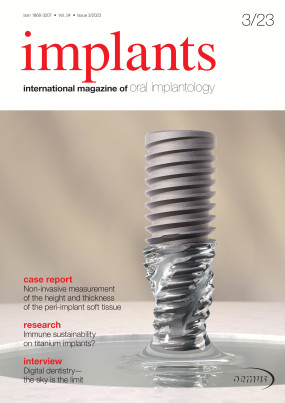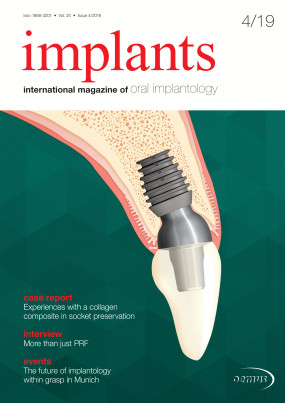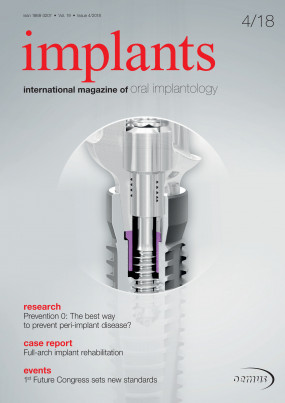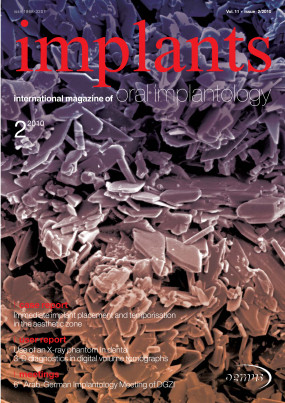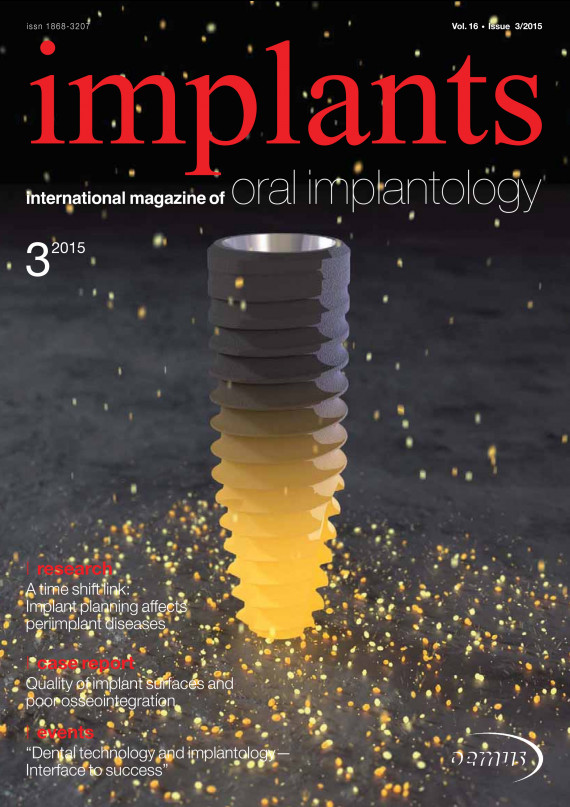Inhaltsverzeichnis
3
6
Implant planning affects periimplant diseases - A time shift link
Rainer Buchmann, Daniel Torres-Lagares & Guillermo Machuca-Portillo, Germany & Spain
Implants are becoming increasingly popular with low-cost offers promoting this development. The number of customers preferring implants to customary restorations is expanding. The variety of client demands, individual settings, treatment options and risks related to inflammation and bone damage following implant treatment advocate evident, comprehensible and durable solutions...
16
Quality of implant surfaces and poor osseointegration - Part II: Irregular surface roughness suspected of causing deficient osseointegration
Drs Nikolaos Papagiannoulis, Andreas Sakkas & Adrian Kasaj, Germany
Modern dental implants are made of a titanium alloy or a combination of titanium and ceramic. Pure titanium implants are also still manufactured. Titanium induces bone on-growth through a direct biochemical interaction with bone tissue. The biological response of the organism is related to the formation of a titanium dioxide layer, as discovered by Per-Ingvar Brånemark and widely applied to orthopaedic treatment...
24
Mandibular body reconstruction with a 3-D printed implant
Dr Saeid Kazemi, Reza Kazemi, Sita Rami Reddy Jonnala & Dr Ramin S. Khanjani, Sweden
Nowadays, no aspect of human life seems to have been left untouched by the ever-expanding digital technology. Particularly in scientific fields, digitalisation has working wonders during the past few years, to the degree that it is even difficult to imagine going back to the ordeal of analogue methods and putting up with their vagaries. A remarkable blessing of digital technology, among others, is the exceptional precision and high control over the measurements, never possible to obtain through any of the preceding methods. There is no surprise then that it has the strongest appeal to the fields of knowledge and practice wherein precision is amongst the most critical element of success...
28
Simplifying implantation in socket and ridge preservation
Martin Keweloh MD, DDS, MSc, Julian Riedasch DDS & Konrad Joisten MD
An adequate amount of bone in both the horizontal and vertical directions is required for successful oral rehabilitation with dental implants. Preservation of the alveolar bone structure after tooth extraction is a critical factor regarding the outcome of this procedure. Bundle bone, which depends on the periodontal tissue, is inevitably lost after tooth extraction.1, 2 As the buccal wall is often very thin and mainly composed of bundle bone, tooth extractions commonly result in a reduction of the alveolar process in the vertical and horizontal directions.1, 3 Such resorption is typically observed in the buccal walls of the upper jaw.1, 4
34
Immediate loading with dynamic navigation implant surgery
Dr Jan D’haese, Dr Johan Ackhurst & Prof. Hugo De Bruyn
Although osseointegration of dental implants is predictable, thorough preoperative planning is a prerequisite for a successful treatment outcome.1, 2 Anatomic limitations and prosthetic considerations encourage the surgeon to obtain a very precise positioning of the implants. Historically, standard radiographic imaging techniques (intra-oral and panoramic) were available for investigation of potential implant sites...
42
In 1981 Thomas Diskrell developed the Titanodont-implant, which was perfected and patented under the name DB Precision four years later. Today it is known under Bicon Dental Implant System. On the occasion of the 30th anniversary Georg Isbaner, editor of the implants magazine, spoke with Prof. Mauro Marincola about the history of the special implant-design, the importance of the German market for Bicon and the future of the dental market.
44
Professionals, students, academics and researchers from different universities had been invited to the International Congress of the Dental Faculty of the UNAM. The focus of the event lied on the public health and private sectors, as well as the general dental community in Mexico. The German Association of Dental Implantology (DGZI) joined the congress, represented by Dr Rolf Vollmer as only representative from Germany (Fig. 1). DGZI speakers significantly influenced the implantological programme.
46
Every three years, the European Federation of Periodontology (EFP) offers dental professionals from various countries the opportunity for exchange through its EuroPerio Congress. This year, the EFP welcomed numerous representatives in the areas of dentistry and dental hygiene to the conference in the UK capital. After the successful EuroPerio7 in Vienna in 2012 with 7,800 participants, the organisers had hoped for increased attendance and, indeed, there were about 10,000 visitors to the London event, which was held from 3 to 6 June (Fig. 1)...
48
Never before has a society placed the focus on the—not always stress-free—collaboration between dentists and dental technicians as the German Association of Dental Implantology (DGZI) has in its theme for the 45th annual congress, which is to be held on 2 and 3 October 2015 in Wiesbaden, Germany. The conference theme is “Dental technology and implantology—Interface to success” and this forward-looking claim is reflected in the programme content...









